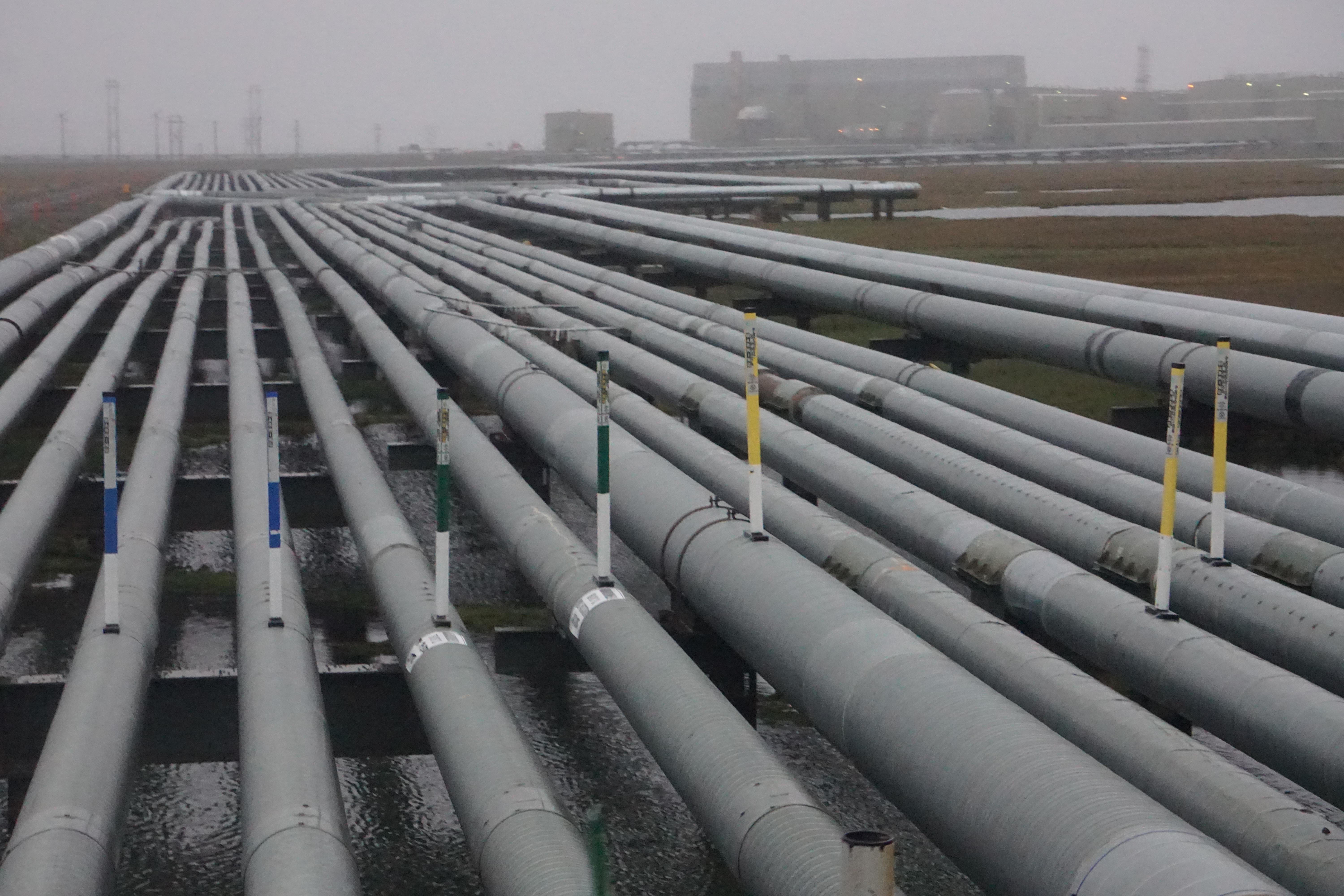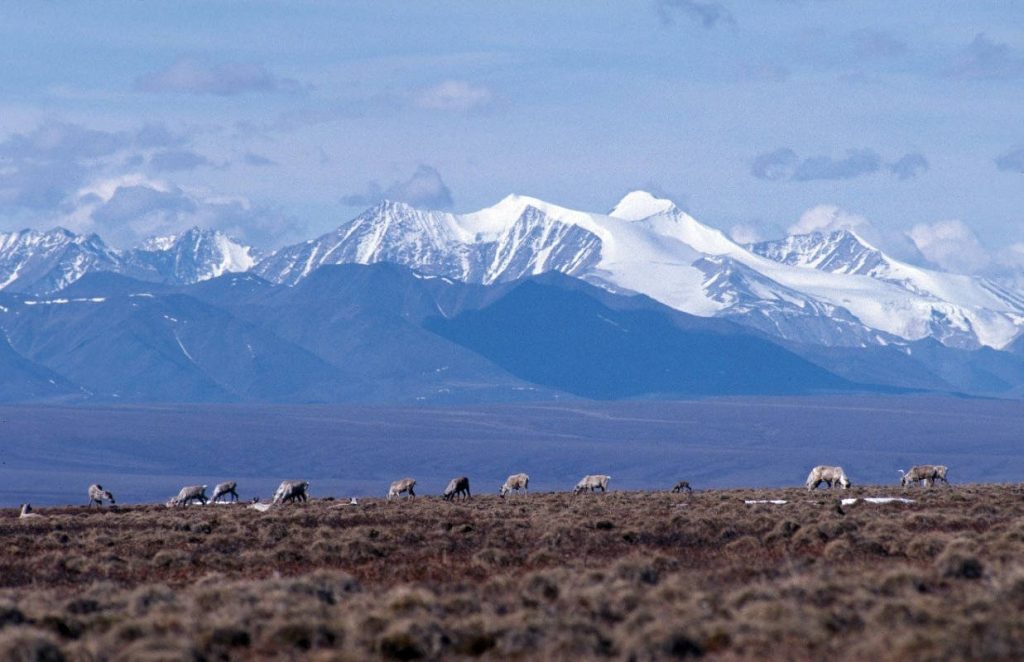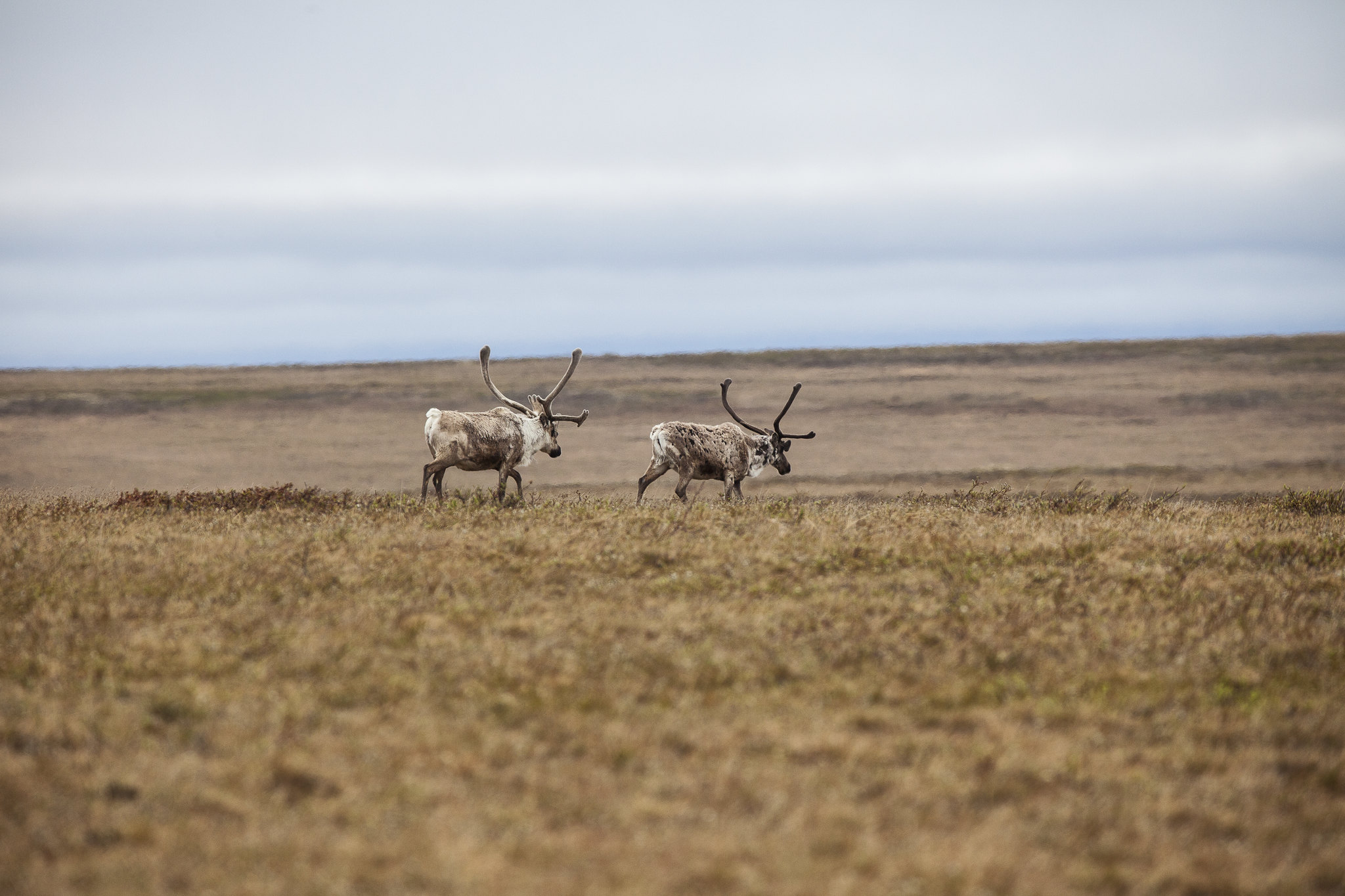Even after decades, caribou still aren’t fully used to oil development, scientists say
After nearly half a century of living around wells, roads and pipelines, caribou still show an aversion to North Slope oil-field infrastructure.

Images of plentiful caribou coexisting peacefully with oil fields have long been staples of the industry’s argument that development is environmentally safe and that wildlife and oil drillers can co-exist peacefully.
But new scientific research tells a different story. After half a century of living amid and around the wells, roads, pipelines and structures that have produced, processed and transported 18 billion barrels of oil, caribou still show an aversion to North Slope oil-field infrastructure, according to a newly published study that is led by scientists at the U.S. Geological Survey.
The subject is the Central Arctic Caribou Herd, which summers in the central coastal plain region that is also home to the huge Prudhoe Bay and Kuparuk fields and related development, and winters in the foothills of the Brooks Range mountains, well south of the oil fields.
The study, published in the Journal of Wildlife Management, analyzes radio-collared caribou’s movements from 2015 to 2017 and compared them to those recorded decades ago when the oil fields were new.
Those oil fields are now a fact of life for the caribou, said Heather Johnson, a USGS wildlife biologist and lead author of the study.
“Generations of caribou have been exposed to this. This is all they know,” Johnson said.
But familiarity is not the same as comfort. The caribou tend to avoid oil infrastructure throughout the summer, the study found, making it the latest in a series of research projects showing that the mix of caribou and oil is uneasy.
The findings “corroborate a growing body of evidence suggesting that habituation to industrial development in caribou in the Arctic is likely to be weak or absent,” the study says. The findings hold lessons for other North Slope caribou herds that will be sharing territory with industrial facilities as oil development expands.
Aversion to oil infrastructure, the study found, is strongest during the calving season. During the time when calves are born, the caribou markedly reduced their use of territory that lies within 5 kilometers of oil infrastructure.

Among the important pieces of evidence is the continued avoidance of what used to be prime coastal territory for calving but is now an important area for industry operations. Research by Alaska Department of Fish and Game biologists found that the presence of an oil-field road dramatically reduced caribou presence in the area, according to a study published in 1992 and related research. That continues to be the case, the latest study noted.
“The area north of the Spine Road — that used to be the core calving area,” said Kyle Joly, a National Park Service biologist who was not part of the latest study but has done other research on development impacts to caribou. “That area’s been almost completely abandoned by calving caribou.”
The aversion is weakest later in the summer, when caribou must move past the oil complex to reach the coast and the breezes that provide some relief from biting mosquitoes. Peak mosquito season saw the reduced use of habitat within 1 kilometer of oil infrastructure — though caribou could not avoid it entirely.
“Caribou do move through the oil fields. They’re there. They move through them regularly during mosquito season,” Johnson said. “They have no choice.”
At times, the caribou even take momentary advantage of the gravel oil pads that rise up from the bug-infested tundra vegetation, she added.
Whether infrastructure has affected the herd’s population size is unclear.
Caribou herds can fluctuate widely in size, and the Central Arctic herd is no exception. In the mid-1970s, just before oil production started, the herd totaled only about 5,000, according to the Alaska Department of Fish and Game. It grew dramatically as development did, peaking at 70,000 in 2010, a fact often invoked by industry supporters. The population then plunged to about 22,000 by 2016. Numbers are now at about 30,000, and a period increased adult mortality appears to have ended, said Beth Lenart of the Alaska Department of Fish and Game, a study co-author.
Caribou are known to adapt to a variety of conditions — a characteristic of high “plasticity” compared to other wildlife. They are found in habitats from the forests of eastern Canada to the treeless Arctic tundra.
But development that cuts up that habitat is also known to damage herds.
Boreal woodland caribou that once roamed about half of Canada, for example, are now classified as threatened because of development that has fragmented their habitat, according to that country’s environmental officials. Those woodland caribou have almost entirely disappeared from the U.S. states along Canada’s southern border.

If North Slope oil development does have demographic effects on the Central Arctic herd, those would likely be complicated, Johnson said. Potential effects could range from individual animal’s body condition to reproductive success to total population size — and there are plenty of other factors in the mix, she said.
Some of those more subtle questions have been probed by earlier studies, such as an Alaska Department of Fish and Game project that found that Central Arctic Caribou Herd calves born in less-developed areas wound up growing larger than those born in areas with more oil development.
The Central Arctic herd’s summer territory is spread over a wide swath of flat tundra, so possibly there is enough habitat for all 30,000 even if oil-field infrastructure has to be avoided, Johnson said.
The oil-field area is only a part of the herd’s habitat, Lenart noted. “It’s not all of it,” she said. Outside of the developed areas, “There’s still a lot of habitat available to the herd.”
The situation could be much different for the larger Porcupine Caribou Herd, which roams between northeastern Alaska and northwestern Canada and totals about 200,000 animals. That herd’s calving ground is the coastal plain of the Arctic National Wildlife Refuge, the precise spot that the Trump administration is preparing to lease for oil drilling. The refuge coastal plain is a relatively narrow wedge of land between Brooks Range mountains and the Arctic Ocean, giving the caribou less space to go to avoid development if it happens.
“You have way more caribou squished into a much smaller place,” Johnson said.
Opponents of ANWR oil development have invoked the welfare of the Porcupine herd. Those opponents include the Gwich’in Athabascan people who live in the Alaska and Canada range of the herd as well as Canadian governments from the tribal to federal level. The Central Arctic herd’s experience bodes ill for the Porcupine herd, they argue.
But the oil industry, in official comments on the leasing plan, maintained that Central Arctic herd has adjusted to oil development and that the Porcupine herd will do the same.
The U.S. Bureau of Land Management, the agency that is overseeing planned ANWR leasing, should recognize that caribou can become accustomed to roads, American Petroleum Institute and Alaska Oil and Gas Association said in a joint comment statement submitted last year. The BLM “should similarly conclude that caribou habituation to development on the Coastal Plain may take time, but is likely to occur, based on the experience of existing fields on the Alaska North Slope,” said the groups’ statement, submitted to influence a final environmental impact statement that was released in September.

New oil development could also clash with Teshekpuk Caribou Herd father west on the North Slope.
At 56,000 strong, the Teshekpuk herd roams marshy terrain dotted with ponds and lakes, moist tundra habitat that borders vast Teskehpuk Lake, the largest lake on the North Slope. It is important territory for migratory birds as well as caribou, but the area is also highly prospective for oil and is now a promising western frontier for industry development.
There are new oil fields already built and big projects in the works that overlap with the Teshekpuk herd’s territory. Even more territory would be opened to drilling if the Trump administration succeeds in its plan to overturn Obama-era protections that put much of the Teshekpuk Lake area off-limits to leasing.
The other caribou herd that could be affected by new development roams territory that is even farther to the west — the Western Arctic Caribou Herd, which at about 244,000 is Alaska’s largest. That herd also uses NPR-A terrain that is currently undeveloped but could be converted into oil fields.
The specter of expanded oil development and other development has alarmed some members of an advisory panel helping to manage the Western Arctic herd. They worry in particular about a proposed 211-mile road that would serve a different mining prospect, the isolated Ambler mining district in northwestern Alaska. The Trump administration and the state of Alaska are pushing for that road into the Brooks Range foothills to make Ambler mining commercially feasible.
Cumulative effects of oil development are forever, Tom Gray, a member of the Western Arctic Caribou Herd Working Group, said at the group’s annual meeting in December.
“When you develop and put infrastructure in a place, that affects subsistence. It doesn’t ever change back to the way it was,” he told BLM representatives attending the meeting.
More research is underway to better understand ways to reduce oil-field impacts on caribou, said Johnson and Lenart. Oil companies acknowledge that mitigation measures are necessary to protect caribou, Lenart said. And even the currently developed areas have some spots of safe passage that are useful to the caribou, she said. It’s not like Los Angeles. There is enough space and tundra in between that allows caribou to move through,” she said.
But for many years, some pro-drilling politicians insisted that oil development was not only harmless to caribou but actually good for the animals.
That claim was made most famously by former President George H.W. Bush. “The caribou love it. They rub against it and they have babies,” he said in 1991 of the Trans Alaska Pipeline.
More recently, then-U.S. Rep. Michele Bachmann, a Minnesota Republican, said in 2008 that North Slope oil-field pads and roads create good conditions for a caribou “coffee klatch.”
And U.S. Rep. Louie Gohmert, a Texas Republican, in 2012 told colleagues that the warmth of the pipeline makes caribou amorous. “So when they want to go on a date, they invite each other to head over to the pipeline,” he said, the Washington Post reported in a story titled “Louie Gohmert: Best Caribou Wingman Ever.”